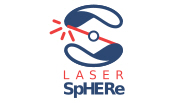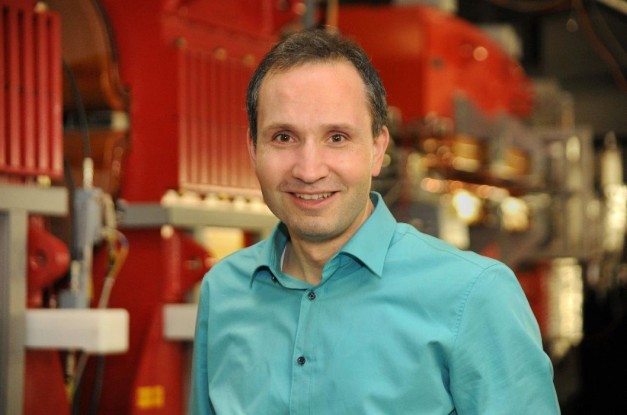Our group studies few-electron systems in strong electromagnetic fields, i.e., highly charged ions (HCI). Especially hydrogen-like and lithium-like heavy ions, such as 207Pb81+, 209Bi80+, 209Bi82+ or 235U91+, offer the unique possibility to investigate fundamental processes and symmetries. This includes the high-precision spectroscopy of dipole-forbidden transitions in highly charged ions to determine the contributions of strong-field quantum electrodynamics in bound systems to the transition energies. This comprises the QED predicted effects known as „vacuum polarization“ and „self energy“, which become very significant in high fields, as they exist around the core of high-Z atoms. Due to the Z9-dependence of the hyperfine-splitting in these ions the M1 transitions can be accessed by well-known laser spectroscopy techniques to resolve these QED contributions with very high precision.
These types of experiments are performed by our group either on HCI-beams trapped in the experimental storage ring (ESR) or on cold and dense ion clouds confined in a Penning trap.
Hydrogen- or lithium-like ions are produced by the GSI accelerator complex to about 70% of the speed of light. They are then injected at into the experimental storage ring (ESR), where six dipole magnets (B = 1 T) keep the ions on a closed trajectory of about 108 m circumference. The ions revolve 2 million times per second (2 MHz revolution frequency). The pressure inside the pipe is extremely low (10-11 mbar) and therefore the ion beam remains stored for many minutes. The typical ion beam current is in the order of few mA, being equivalent to 108 stored ions. Additionally, “cold” electrons produced by an electron cooler help to reduce the momentum spread of the ions significantly giving rise to a high-brilliance ion beam. In this case, the voltage applied to the electron cooler defines the ions' velocity.
As can be seen in figure 1 , the ring has two long straight sections. The fast ion-beam is superimposed with a counterprpropagating or a copropagating laser beam along the electron cooler section. Because the relativistic ion velocity, the Doppler-shift of light changes the wavelength by more than a factor of 2 and by exploiting the two propagation directions, we can use a single tunable day laser system in the visible to probe both hyperfine transitions, even though one is in the ultraviolet (243 nm) and the other in the infrared (1555 nm). Details of the setup can be found in [J. Phys. B 50, 085004 (2017)].
The upper hyperfine state has a lifetime much longer than a revolution period. Therefore the fluorescence lasts for thousands of ion revolutions. In order to efficiently collect this fluorescence, a dedicated optical detection system, shown in figure 2, has been developed in the group of Prof. Weinheimer at the University of Münster [J. Instr. 8, P09018 (2013)].
Recent Results
In 2011 we observed the 2s hyperfine transition in lithium-like bismuth for the very first time. In combination with a new measurement of the 1s hyperfine splitting in hydrogen-like bismuth we extracted the specific difference and found good agreement with the theoretical prediction. Yet the accuracy of our result was limited by the calibration of the electron cooler voltage.
We have repeated the experiment with improved equipment in 2014. This time we could monitor the electron-cooler voltage in situ using a voltage divider provided by PTB (Germany’s national metrology institute) in Braunschweig.
After rigorous analysis of possible systematic effects, we have now achieved a relative accuracy in the order of 10-5 for both hyperfine transitions. These are an order of magnitude better than our previous results and represent the most accurate transitions measured in a heavy highly charged ion so far.
Surprise: Our result for the specific difference shows a seven-sigma discrepancy from the most recent and most accurate theoretical prediction [Nat. Commun. 8, 15484 (2017)]. The effect is larger than the complete screened QED contribution and must have a different origin. Either the tabulated magnetic moment is considerably different from the tabulated value or the cancellation of nuclear structure in the specific difference is not as complete as expected. Without this cancellation bound-state QED tests in strong magnetic fields remains uncertain. We look forward to more experiments to elucidate this “hyperfine puzzle” [Nature Physics 13, 533–534 (2017)] !
Solution of the Hyperfile-Puzzle?
NMR measurements of bismuth compounds with nuclear magnetic resonance (NMR) showed that the tabulated magnetic moment of the bismuth isotope with mass number 209 is most probably not correct. Using our newly determined magnetic moment including corrections for chemical shifts and diamagnetism, brings the theoretical prediction for the specific difference in agreement with the experimental value within the – now a little bit larger – uncertainty [Phys. Rev. Lett. 120, 093001 (2018)].
Future
Beamtime for further experiments has been recently granted by the G-PAC. Our goal is to develop a new – more sensitive – technique for the detection of the infrared transition in Li-like ions using dielectronic combination (DR). This DR-assisted laser spectroscopy will also allow to perform measurements on other species of HCI, where fluorescence detection is not applicable. It will be demonstrated with Bi-209 and then applied to the radioactive isotope Bi-208.
Ultimately, measurements at cold highly charged ions in Penning traps will provide much higher accuracies and will help to resolve the Hyperfine Puzzle and will perform tests of bound-state strong-field QED at accuracies improved by 2-3 orders of magnitude.
Based on the achieved results with stored ion beams in the ESR, a new experiment was designed that opens new perspectives in the field of high precision spectroscopy on HCI. Further, it offers the possibility to study the ion dynamics and different cooling methods of multispecies ion clouds under extreme conditions.
The high precision can only be achieved by reducing the energy distribution and therefore the Doppler broadening of the ionic ensemble. This requires a cooling strategy that enables us to cool highly charged ions to sub-Kelvin temperatures. Thus, we follow a cooling strategy based on laser-cooled singly charged magnesium ions for sympathetic cooling of any species of HCIs. Additionally, the trap is designed to investigate the effect of resistive cooling on large ion clouds, which becomes favourable at high charge states. Therefore our group develops new techniques for studying the ion dynamics of strongly interacting, multispecies ions clouds at low temperatures.
The experimental apparatus consists of a cylindrical open-endcap Penning trap (see figure 1) embedded in a cryogenic environment. The magnetic field is provided by a superconducting magnet with Helmholtz configuration. The ions are externally produced by different kinds of ions sources (e.g. Dresden EBIT), which are located at the HITRAP facility at GSI. Dynamically switching of the trap electrodes allow us to accumulate several ions spezies in our trap. By varying the trap voltages, precise control of the spatial position of the ion cloud is possible and allows us to manipulate the ion density by using the rotating wall technique. The laser beams for cooling and spectroscopic investigations are superimposed with the ion cloud in axial direction, while the fluorescence light can be collected radially.
Finally, the ion dynamics can then be studied by imaging the ion cloud on a CCD-camera, as it is shown for instance in figure 2.
We have a strong collaboration with the group of Prof. Thompson from the Imperial College London, Prof. Weinheimer’s group at the University of Münster and with Prof. Birkel’s team here at the TU Darmstadt.

Another storage-ring called CRYRING has been installed at GSI Helmholtz Centre for Heavy Ion Research in Darmstadt. A picture of the facility is shown in figure 1 . In association with the GSI accelerator facility, at CRYRING lowly and highly charged ion-beams can be established. Energies will range from 30keV/u up to 20 MeV/u. In addition to injection from ESR, there also will be the possibility to get ions from a Nielsen-type ion-source.
In September 2017 the ring was successfully filled with H2+-ions. Acceleration and bunching was tested during this beam time as well. At present, the ion-source is expanded by an oven for making metal-ions accessible. With these ions, first collinear laser spectroscopy experiments will be performed at CRYRING.
One goal is to establish a polarized ion-beam for the first time by optical pumping in a storage ring. Therefore the D1-transition 3s 2S1/2 → 3p 2P1/2 of the Mg+-ion at 280,35 nm is the candidate for the proof of principle experiment.
The fluorescence chamber for these laser spectroscopy experiments has been built by the group of Prof. Dr. Christian Weinheimer at University of Münster. The short shutdown in January 2018 will be used for mounting this chamber at CRYRING. The laser system and transport as well as the data acquisition are currently in progress. In this context, both bachelor and master theses are available.















